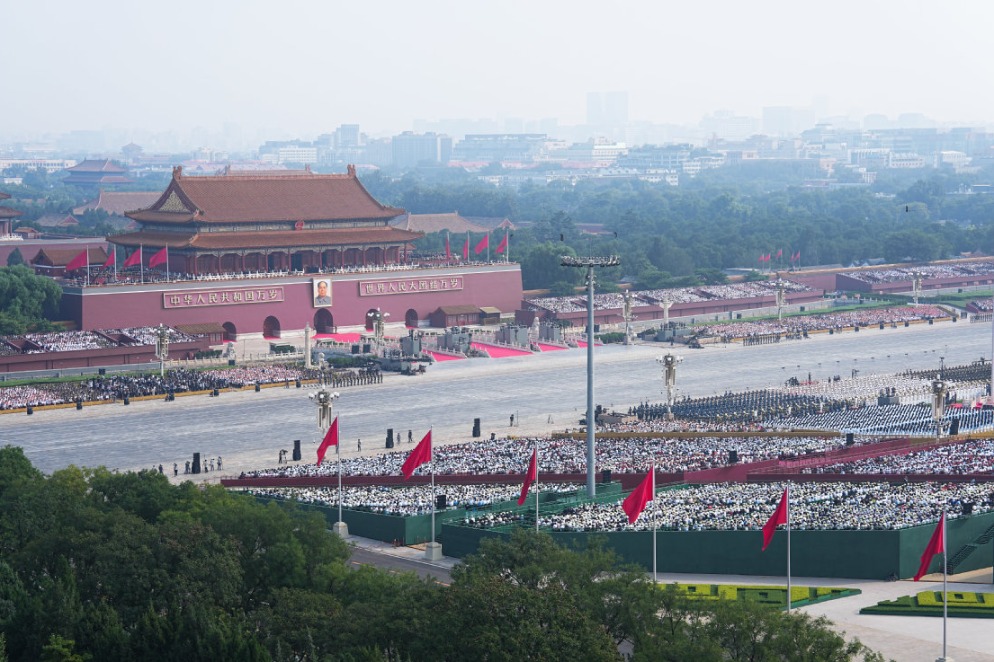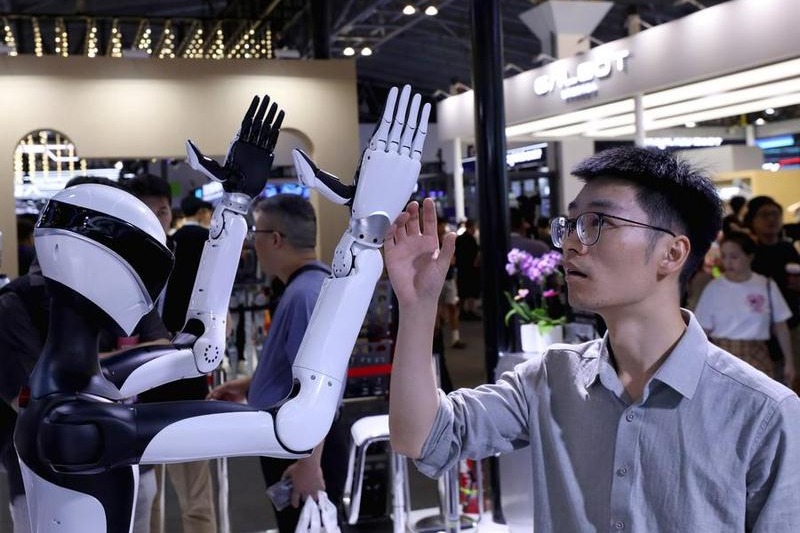Focused on improving growth


China's GDP growth increased to 6.3 percent year-on-year in the second quarter of this year — largely due to a low-base effect as growth fell to 0.4 percent in the second quarter of 2022 as a result of COVID-19 prevention and control measures.
We (at Standard Chartered Bank) moderately lower our third and fourth quarter growth forecasts to 5.3 percent and 5.6 percent year-on-year, respectively (from 5.5 percent and 5.9 percent previously). However, our 2023 GDP growth forecast remains unchanged at 5.4 percent, as the second quarter growth was better than our estimate of 5.8 percent.
Likelihood of large stimulus has reduced
The downward revision reflects our view that the likelihood of a large stimulus by China has reduced as growth stabilized and improved slightly in May-June after a sharp slowdown in April; and the housing market is likely to remain sluggish in the second half of this year, as indicated by our May survey of China developers.
China's leadership has shown greater composure and strategic focus in responding to recent easing economic growth. And new policies have been oriented toward improving long-term growth prospects, as reflected in President Xi Jinping's call to establish a higher-level open economy at the meeting of the Central Commission for Comprehensively Deepening Reform on July 11.
The two-year compound annual growth rate (CAGR) for urban household disposable income and consumption expenditure slowed to 4.3 percent and 3.0 percent in the second quarter, from 4.7 percent and 5.3 percent in the first quarter, respectively.
On a rolling annual sum basis, disposable income growth recovered to 4.9 percent at the end of the second quarter, while consumption expenditure growth rose to 3.6 percent, still slower than the pre-pandemic growth of 6.5-8.0 percent during 2017-19.
The slower recovery in consumer spending versus income growth suggests that people continued to accumulate precautionary savings amid weak confidence and increased job insecurity. According to a People's Bank of China's survey on depositors, the employment sentiment index fell deeper into contraction territory in the second quarter to 37.6 percent from 39.9 percent in the first quarter. Also, the youth job market deteriorated further in June, with unemployment rate rising to 21.3 percent from 20.8 percent in May.
Month-on-month sales growth eased
Retail sales growth on a month-on-month seasonally adjusted basis eased to 0.23 percent in June from 0.39 percent in May. And the two-year CAGR improved to 3.1 percent year-on-year in June from 2.5 percent in May, still much slower than the pre-pandemic average growth of 9 percent during 2017-19.
The two-year CAGR for industrial production improved to 4.1 percent year-on-year in June from 2.1 percent in May led by automobile and electric machinery manufacturing, while the two-year CAGR for services production accelerated to 4 percent from 3 percent in May despite headline year-on-year growth slowing due to a high-base effect.
Going forward, we expect the industrial sector to continue to face headwinds from falling housing investment and slowing export growth, while the transportation and hospitality sectors may recover further on China's reopening.
Besides, investments in the manufacturing sector grew 6 percent year-on-year in June (against 5.1 percent in May), while investments in infrastructure increased 6.4 percent year-on-year (against 4.9 percent in May).
Housing floor space sold fell 17.3 percent year-on-year in June, with two-year CAGR for housing floor space sold falling to — 20.4 percent year-on-year in the second quarter from — 8.5 percent in the first quarter. And real estate investment continued to decline, by 10.2 percent in June, the same as in May.
Our proprietary China Development Sentiment Index for the second half of this year, accordingly, has slid further to 38.2, from 40.6 for the first half. A short-lived post-reopening rebound in new home sales, weaker-than-expected home sales in the second quarter, and expectations of fading effects of new housing stimulus policies likely made developers more cautious on the sales outlook.
As for homebuyers, they remain wary amid a lagged recovery in income, increased job insecurity and slowing economic growth momentum.
China's exports declined further, by 12.4 percent year-on-year in June, as compared to a 7.5 percent drop in May. By destination, exports to the eurozone, the United Kingdom, Japan, the United States and Latin America fell 6.5 percent, 3.4 percent, 4.7 percent, 16.9 percent and 0.5 percent, respectively, in the first six months of 2023; while exports to ASEAN member states and African countries rose 2.4 percent and 16.9 percent, respectively.
Also, an economic slowdown in the US and the eurozone is likely to continue to weigh on China's export growth in the rest of the year.
By product, exports of computers, electronic integrated circuits and household appliances fell 24.1 percent, 17.6 percent and 2.4 percent, respectively, in the first six months because of tighter US controls on its technology exports and slowing external demand.
China now world's most dynamic EV market
In contrast, exports of motor vehicles and electrical accumulators were particularly strong, up 108.2 percent and 58.2 percent year-on-year, respectively, in the first half, reflecting China's unique strength in clean energy-related manufacturing.
China is now the world's largest and most dynamic electric-vehicle market, with its EV exports jumping 153.7 percent year-on-year in the first five months of this year following a 122 percent growth in 2022.
According to industry experts, China's EV makers have been able to outcompete German and Japanese brands, which have traditionally been the leaders in the non-EV sector, on two major fronts: smarter cockpit configurations (for instance, better infotainment systems, head-up displays, voice interaction and multiple passenger screens); and more dedicated platforms for EVs that allow China's carmakers to introduce new models faster than foreign brands at more competitive prices.
China's import value fell 6.8 percent year-on-year in June (as compared with a 4.5 percent drop in May) largely due to falling commodity prices.
In terms of volume, China's year-to-date imports of major commodities rebounded strongly off a low base — crude (11.8 percent year-on-year), natural gas (5.7 percent), coal (93.2 percent) and soybean (13.6 percent) — suggesting a continued gradual recovery in domestic demand. The monthly trade surplus, however, remained elevated at $70.6 billion in June.
We have observed three new trends in recent years that are likely to continue to shape China's future trade balance: the new energy industry has become a major contributor to China's trade surplus, with net exports of EVs and electric accumulators contributing 27.3 percent of the year-on-year increase in trade surplus in the first five months; the US' recent tightening of semiconductor export controls has inadvertently resulted in a higher trade surplus for China (although this situation may not last forever); and China's rising consumer demand has made it an increasingly larger net importer of food and pharmaceuticals.
Gradual recovery in consumer confidence
We expect a gradual recovery in consumer confidence and measured policy stimulus to sustain China's economy on a moderate recovery path in the second half, expanding 5.3 percent year-on-year in the third quarter and 5.6 percent in the fourth, and 5.4 percent in the whole of 2023.
Our policy forecast remains unchanged. We expect the People's Bank of China to lower the reserve requirement ratio by 25 basis points each in the third quarter of 2023 and the first quarter of 2024 to ensure sufficient liquidity for the growth of M2 (the amount of money in circulation plus non-interest-bearing bank deposits and national savings accounts) and total social financing. More important, we expect no more medium-term lending facility rate cuts for the rest of 2023.
We also think China is likely to further loosen the housing policy, especially in tier-1 cities; maintain fiscal stimulus, including possibly approving an additional local government special bond quota of 500 billion yuan ($69.96 billion) in 2023 if land sale revenue is significantly below the budget; and support infrastructure investment growth via increased policy bank lending.
In fact, we expect only measured stimulus in response to the recent recovery setback, because the latest data suggest economic growth stabilized in May-June after a sharp slowdown in April. Also, over-reliance on stimulus could derail China's stated pursuit of high-quality development, and policymakers likely see the effectiveness of macro stimulus diminishing.
Moreover, China's leadership has shown greater patience and composure in responding to easing economic growth of late, and is strategically focused on new policies to improve long-term growth prospects.
The author is senior economist of Standard Chartered Bank for China. The views don't necessarily reflect those of China Daily.
If you have a specific expertise, or would like to share your thought about our stories, then send us your writings at opinion@chinadaily.com.cn, and comment@chinadaily.com.cn.
































